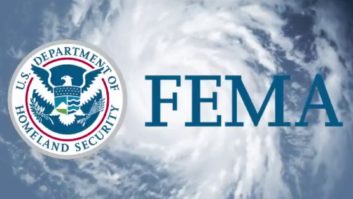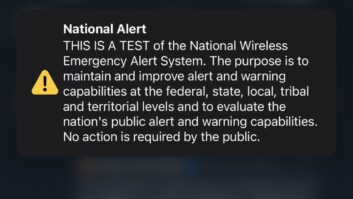Paul McLane is U.S. editor in chief.
Over breakfast in the last day or so, did your “significant other” look up from the paper or away from the TV news and ask you whether you knew about this “national EAS test thingie”?Did you receive an informational message on your cable TV screen about EAS this week, or maybe an email from your county emergency authorities? If so you weren’t alone.
Today’s EAS test is showing up in the national consciousness, as broadcasters and regulators have been trying to get the word out so listeners and viewers aren’t alarmed.
Meanwhile engineers around the country made final checks that their gear was set up properly to ensure success. Information flew among EAS participants offering each other advice, asking and answering questions, pointing each other to FCC and FEMA resources.
In Los Angeles, SBE Chapter 47 was focused on EAS at its monthly meeting, with expert Richard Rudman speaking.
In San Diego, Bill Thompson, chief engineer for Clear Channel station KOGO(AM), an LP-1 station, distributed an update that was published by the CGC Communicator newsletter. KOGO (like a couple dozen other U.S. stations) recently joined the ranks of Primary Entry Point stations, so it sent an RWT this past weekend from its “new” PEP Sage Endec. “KOGO will air the National EAN as a Primary Entry Point,” Thompson wrote. “The whole thing should work well. However, just in case the EOM tones fail to ‘make the trip,’ KOGO will immediately after the EAN run an RWT, from the studio, just to be sure that EOM tones go out down the line.”
On the opposite coast, the state of Connecticut also has a new PEP station, WTIC(AM). Until recently, Connecticut relied on monitoring PEPs in New York and Boston, an arrangement that left some stations served poorly or not at all. SECC Chair Wayne Mulligan, who is VP of emergency services for the Connecticut Broadcasters Association, told me yesterday that state officials had reviewed and revised their monitoring arrangements earlier this year. Mulligan was calm about the national test, saying the state’s system is tested with RMTs regularly in “pretty much the same way it’ll be run” for the national test today. He received only one question from a state broadcaster looking for help to prepare; that was about setting up a particular encoder/decoder properly. There are about 100 licensed broadcast stations in the state.
He’ll monitor the test from Hartford. “When the test was three minutes long, I thought I’d have time to do quite a bit of monitoring. It’s more difficult at 30 seconds, but I’ll be in the area checking as much as I can.” CBA sent a form to member stations asking them to report to Mulligan so he can compile a “how we did” list.
Some comments I’ve read about the test have carried something of a desperate air, e.g. “Let’s hope we don’t screw this up.” I suppose I understand this vibe; after all, we don’t want radio itself to look foolish or unreliable. But the point of the test is to see how well the system works and to identify areas where it doesn’t. Broadcasters should stress less about this event. Regulators have made clear that this is not an “enforcement activity.” Understand that this is but one step in an ongoing process. Further, if you are among those who are critical of how EAS runs, here’s your chance to document your concerns.
Roll with it today — but take good notes. Anything that happens, good or bad, helps build a better system.











